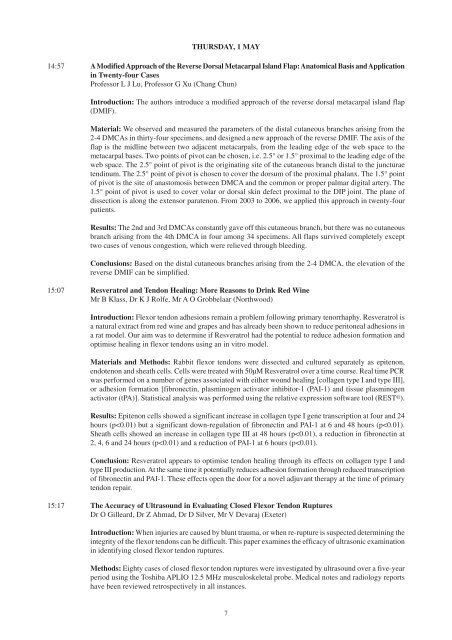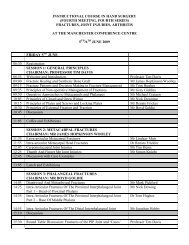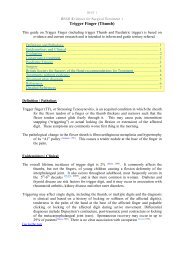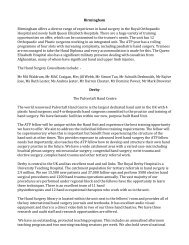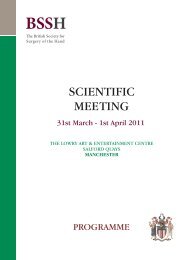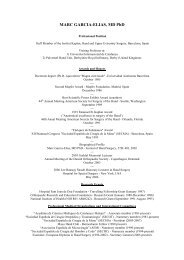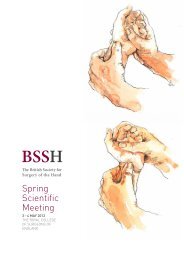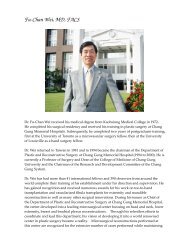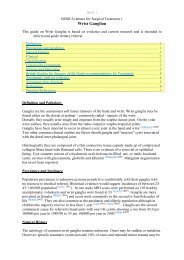here - The British Society for Surgery of the Hand
here - The British Society for Surgery of the Hand
here - The British Society for Surgery of the Hand
Create successful ePaper yourself
Turn your PDF publications into a flip-book with our unique Google optimized e-Paper software.
THURSDAY, 1 MAY<br />
14:57 A Modified Approach <strong>of</strong> <strong>the</strong> Reverse Dorsal Metacarpal Island Flap: Anatomical Basis and Application<br />
in Twenty-four Cases<br />
Pr<strong>of</strong>essor L J Lu, Pr<strong>of</strong>essor G Xu (Chang Chun)<br />
Introduction: <strong>The</strong> authors introduce a modified approach <strong>of</strong> <strong>the</strong> reverse dorsal metacarpal island flap<br />
(DMIF).<br />
Material: We observed and measured <strong>the</strong> parameters <strong>of</strong> <strong>the</strong> distal cutaneous branches arising from <strong>the</strong><br />
2-4 DMCAs in thirty-four specimens, and designed a new approach <strong>of</strong> <strong>the</strong> reverse DMIF. <strong>The</strong> axis <strong>of</strong> <strong>the</strong><br />
flap is <strong>the</strong> midline between two adjacent metacarpals, from <strong>the</strong> leading edge <strong>of</strong> <strong>the</strong> web space to <strong>the</strong><br />
metacarpal bases. Two points <strong>of</strong> pivot can be chosen, i.e. 2.5° or 1.5° proximal to <strong>the</strong> leading edge <strong>of</strong> <strong>the</strong><br />
web space. <strong>The</strong> 2.5° point <strong>of</strong> pivot is <strong>the</strong> originating site <strong>of</strong> <strong>the</strong> cutaneous branch distal to <strong>the</strong> juncturae<br />
tendinum. <strong>The</strong> 2.5° point <strong>of</strong> pivot is chosen to cover <strong>the</strong> dorsum <strong>of</strong> <strong>the</strong> proximal phalanx. <strong>The</strong> 1.5° point<br />
<strong>of</strong> pivot is <strong>the</strong> site <strong>of</strong> anastomosis between DMCA and <strong>the</strong> common or proper palmar digital artery. <strong>The</strong><br />
1.5° point <strong>of</strong> pivot is used to cover volar or dorsal skin defect proximal to <strong>the</strong> DIP joint. <strong>The</strong> plane <strong>of</strong><br />
dissection is along <strong>the</strong> extensor paratenon. From 2003 to 2006, we applied this approach in twenty-four<br />
patients.<br />
Results: <strong>The</strong> 2nd and 3rd DMCAs constantly gave <strong>of</strong>f this cutaneous branch, but t<strong>here</strong> was no cutaneous<br />
branch arising from <strong>the</strong> 4th DMCA in four among 34 specimens. All flaps survived completely except<br />
two cases <strong>of</strong> venous congestion, which were relieved through bleeding.<br />
Conclusions: Based on <strong>the</strong> distal cutaneous branches arising from <strong>the</strong> 2-4 DMCA, <strong>the</strong> elevation <strong>of</strong> <strong>the</strong><br />
reverse DMIF can be simplified.<br />
15:07 Resveratrol and Tendon Healing: More Reasons to Drink Red Wine<br />
Mr B Klass, Dr K J Rolfe, Mr A O Grobbelaar (Northwood)<br />
Introduction: Flexor tendon adhesions remain a problem following primary tenorrhaphy. Resveratrol is<br />
a natural extract from red wine and grapes and has already been shown to reduce peritoneal adhesions in<br />
a rat model. Our aim was to determine if Resveratrol had <strong>the</strong> potential to reduce adhesion <strong>for</strong>mation and<br />
optimise healing in flexor tendons using an in vitro model.<br />
Materials and Methods: Rabbit flexor tendons were dissected and cultured separately as epitenon,<br />
endotenon and sheath cells. Cells were treated with 50µM Resveratrol over a time course. Real time PCR<br />
was per<strong>for</strong>med on a number <strong>of</strong> genes associated with ei<strong>the</strong>r wound healing [collagen type I and type III],<br />
or adhesion <strong>for</strong>mation [fibronectin, plasminogen activator inhibitor-1 (PAI-1) and tissue plasminogen<br />
activator (tPA)]. Statistical analysis was per<strong>for</strong>med using <strong>the</strong> relative expression s<strong>of</strong>tware tool (REST © ).<br />
Results: Epitenon cells showed a significant increase in collagen type I gene transcription at four and 24<br />
hours (p


